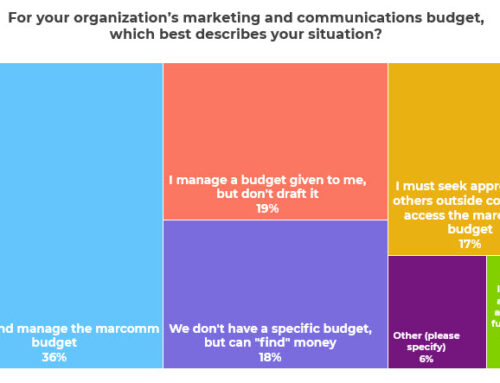On Tuesday, I shared a Theory of Change for nonprofit marketing.
 Today, let’s try to clear up some confusion about the terms that are flying around in our field. For example, what is “content marketing” and why should nonprofits shift toward it?
Today, let’s try to clear up some confusion about the terms that are flying around in our field. For example, what is “content marketing” and why should nonprofits shift toward it?
Here’s how I define content marketing for nonprofits:
Content marketing for nonprofits is creating and sharing relevant and valuable content that attracts, educates, motivates, and inspires your participants, supporters, and influencers so that they can help you achieve your mission.
Creating and sharing communications that are truly relevant and valuable to others outside your organization will require a major transformation within many nonprofits. The kind of transformation is consistent with what’s happening in the larger world of for-profit marketing too, beyond the nonprofit sector.
It’s the difference between “interruption” marketing tactics that scream “Look at me! Help me!” and “attraction” or “permission” or “inbound” marketing tactics that say, “Do you care about this? If so, Let’s talk. We do too.” It’s less calling out, and more natural, open conversations.
With old-style interruption marketing, you push out a lot of information, hoping that it reaches the right people. We also call this “spray and pray.” Much of what we consider traditional nonprofit marketing – newsletters, press releases, event advertising – is outbound marketing.
With inbound marketing, however, you create content that people want, they identify themselves as being interested in your topics, and they actively ask you to communicate with them. You do that by creating content and sharing it, so that when people are actively searching for resources on your topic, they find you. You become known as a great source of information on your topic, so that others see you as the expert and refer their friends and family to you. You create such good stuff that people can’t help but talk about it, can’t help but share it, and everyone notices that. They come to you via searches or because they see others they already know and trust talking about you on Facebook or on Twitter or on YouTube.
If you are interested in getting mainstream media attention . . . guess what? Inbound marketing works on reporters too! They use Google searches and social media just like everyone else to find story leads and expert sources.
You share your interesting content and start those conversations on topics you and your participants and supporters care about in many different places, which leads to what’s called “multi-channel” marketing or “integrated” marketing. No one communications channel is enough anymore. In our 24/7 media environment, the reality is that nonprofits need to use multiple forms of communication – or multiple channels — to effectively reach their participants and supporters. But you can’t just spread messages throughout all of these channels willy nilly. You need to coordinate and integrate your messaging. Knowing which channels to use and coordinating how your messages go out across them is also part of your content marketing strategy.
Finally, you may have heard the term “brand journalism” and it will likely be a big part of your content strategy too. Because no one single story or ad will fully explain what an organization is all about, brand journalists tell lots of stories over time, that as a whole, convey the interests and values of an organization. Brand journalists tell stories about what’s happening within an organization, about the people being served, and take us behind the scenes so that we better understand what’s at stake and the role we might play in that larger story.
If your organization has already adopted a “donor-centered” approach to your fundraising communications, then you will see content marketing as a logical extension covering all of your communications, with all of your participants, supporters and influencers, not just your donor stewardship pieces, and not just to recruit new donors.
What nonprofit communications terms have you confused?






